Just over six months ago, two Android handsets, the HTC Dream and HTC Magic, accounted for almost all of the Android traffic on mobile advertising service AdMob’s network. As the Android market has grown, so has the diversity of devices. Today, 11 different device make up 96% of AdMob’s Android traffic. According to AdMob’s latest metrics, old versions the Android operating system – versions 1.5 and 1.6 – still account for over 60% of all the Android traffic on AdMob’s network. Devices running Android 2.0 and 2.1only make up about 35% of all the traffic.

On the iPhone, on the other hand, the two latest versions of the iPhone OS (3.1.2 and 3.1.3) generated over 86% of AdMob’s iPhone traffic last month. Given the fragmentation in the Android market, it doesn’t come as a surprise that many users never got a chance to update to the new OS.

Chances are that we will see slightly more fragmentation in the iPhone market later this year, once Apple releases version 4 of the iPhone OS, which won’t support the first generations of the iPhone and iPod touch. In total, however, these first-generation devices only account for a small slice of all iPhone traffic (about 5%) and won’t impact the overall statistics too much.

In the U.S. the Motorola Droid, HTC Dream and Motorola CLIQ are the most popular Android phones, while the HTC Hero is the most popular Android handset in the UK, followed by the HTC Dream and the HTC Magic.
While the HTC Droid was responsible for about 32% of all the Android traffic on AdMob’s network, the Google Nexus One only drove about 2% of visitors in March 2010.
Looking at the overall market, AdMob also notes that the Android platform has seen rapid growth over the last year, with a compounded growth rate of about 32% since March 2009. Traffic on AdMob’s own network is also up 18% month over month.
It’s important to point out that these statistics are based on traffic to sites that feature AdMob’s mobile advertising. AdMob’s network is big enough to function as a good proxy for general trends in the mobile space, but it’s always worth taking the exact numbers with a grain of salt.

















